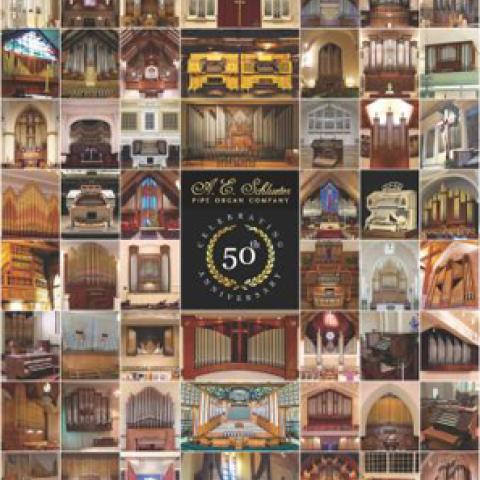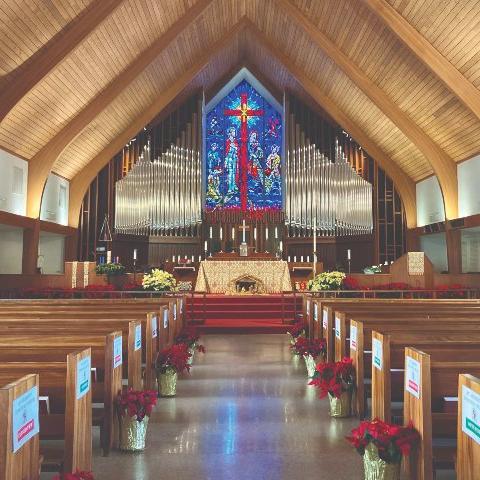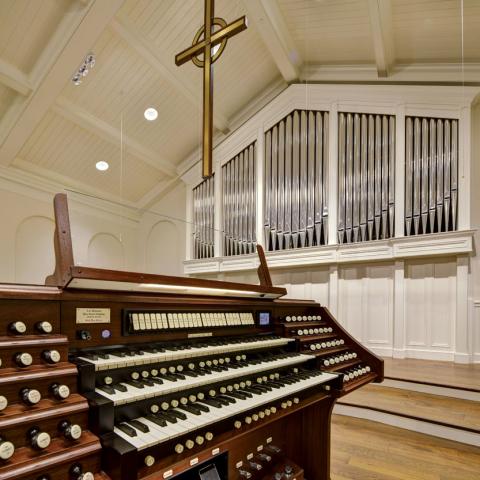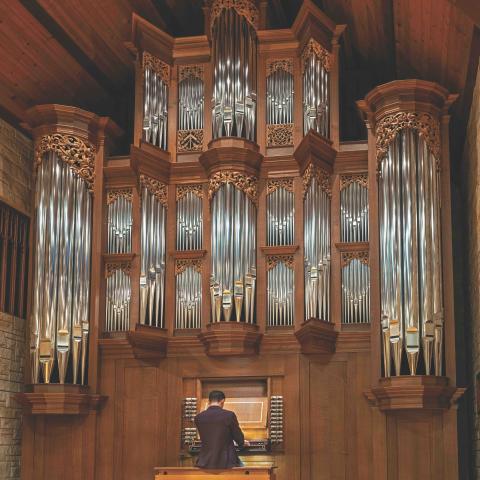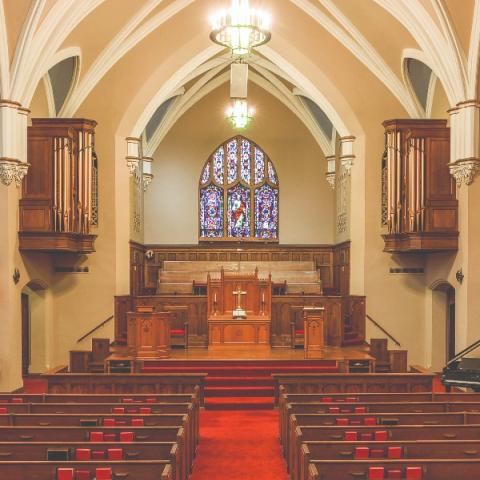A. E. Schlueter Pipe Organ Company, Lithonia, Georgia; 50th Anniversary

We are privileged to be celebrating our 50th anniversary and are thankful for the organ work that has been entrusted to the company. This past December we held our Christmas luncheon with many of our staff, supporters, and friends, and offered a prayer of thanksgiving for our success and all who have sustained us. It is humbling to be celebrating this milestone in work that supports worship.
The A. E. Schlueter Pipe Organ Company was founded by Arthur (“Art”) E. Schlueter, Jr. In his youth Art met an English organ builder who befriended him and introduced him to church organs, theatre organs, and taught him how to rebuild the bellows on a pump organ at his church. He later took Art on as a part-time employee during his high school years, where he continued learning pipe organ maintenance and tuning.
After his high school graduation Art pursued a college education by obtaining degrees in education and education administration. He later moved to Atlanta, Georgia, to work in accreditation for the Southern Association of Colleges and Schools (SACS). Art continued organ tuning and repairs on the side (once an organ man, always an organ man). Having recognized that pipe organs were his real passion and required his full attention, Art changed his role at SACS to part-time consulting and eventually left SACS to work in the pipe organ field full time.
Founding of the company
Our company history began in 1973 when Art applied for an official business license as an organbuilder. The motto of the company was established as “Soli Deo Gloria” and incorporated into the company logo. This admonition has continued to remind us of the importance of our work and is engraved on all of our consoles.
In the early years of the firm, in addition to our tuning and maintenance work, we provided representation and installation services for a major pipe organ manufacturer. Our company quickly grew to maintain organs for more than 100 clients. Pivotally, during this early period, the firm started to undertake rebuilding and expansion of extant instruments under its own name. Being a rebuilder and maintenance company had the importance of exposing the firm to organbuilding across a broad spectrum of styles—tonally, mechanically, and temporally. It could truthfully be said that the greatest impact on who we became as an organbuilder was the foundation provided by those who came before us. With great pride we consider that such renowned firms as Skinner Organ Company, Aeolian-Skinner Organ Company, M. P. Möller, Hook & Hastings, Geo. Kilgen & Son, and Henry Pilcher’s Sons were, and are, our teachers.
The initial business location was in the basement of Art’s Atlanta home. From these humble beginnings, the business gradually outgrew successive temporary and rented buildings until 1988, when the current complex was begun. It has been expanded three times to its current 22,000 square feet of space. The facilities of our firm include a modern woodworking shop, a voicing room, a drafting and engineering room, and a spacious warehouse area that houses the computer numeric controlled (CNC) machine, storage, and erecting room.
As the company grew, all of Art’s five children had the opportunity to work in the business. From age five, the oldest of Art’s children, Arthur E. Schlueter III (“Arthur”), had been offered the opportunity to hold notes while tuning and go out on service calls. Arthur recalled: “As a family business, the pipe organ was part of our lives. Where most people had a formal dining room, this room housed a pipe organ. Where most people had a family room, we had a two-manual pipe organ console, and a basement with a pipe organ blower and relays.” Much as his father had worked on pipe organs during high school, so it was the same for Arthur. While Art’s other children went on to other vocations, Arthur considered this as his career, but it was important to him to leave the business for college and reinforce that it was the right decision. While pursuing a bachelor’s degree in marketing, he continued to keep a hand in music with organ and piano lessons and classes in music and music theory. As he states, after having been away from the company, “when I graduated in 1990 there was clarity that my place was at the family firm and that there was a very strong vocation not only to work on pipe organs but to build them under the family name.”
Building Schlueter pipe organs
This came to fruition when, not long after joining the firm, Art and Arthur made the decision to cease representation for others and to begin building pipe organs under the A. E. Schlueter name. It was important to decide who we were and how we would define our business. What developed was a philosophy to “build instruments that have warmth not at the expense of clarity, and clarity not at the expense of warmth, and to serve God in our efforts.” This philosophy encapsulated our tonal vision while reminding us who we serve in our work.
In addition to building new pipe organs, our business builds custom replacement organ consoles and has provided additions for a large number of extant pipe organs. The consoles built by our firm have included traditional drawknob, terraced drawknob, tablet, and horseshoe styles. This custom work ranged from one manual to five manuals in size.
As a major rebuilder, our firm has rebuilt numerous instruments built by companies long since passed and many by firms currently in business. The same quality and ethics we use in organbuilding are employed in organ rebuilding. Traditional materials and methods assure that the intent of the original builder is maintained. When tasked by our clients, our firm can be sensitive to preserving instruments as originally installed without any alteration. With discernment, we are also willing to consult on changes that can expand the tonal capabilities of the organ.
Some of our historically sympathetic rebuilding projects have included restoration of nineteenth- and early twentieth-century mechanical-action instruments. The ongoing restoration of the four-manual, 74-rank Möller/Holtkamp and three-manual, 36-rank Möller/Holtkamp organs at the United States Air Force Academy Protestant and Catholic chapels is being carefully documented, and both organs are being restored without any major changes or alterations.
The instruments built by our company will have a lifespan beyond our own, and this guides our emphasis on quality and long-term durability of our components and methods. In addition to the visual and aural beauty of the pipe organ, we maintain that there is beauty in the choices of joinery and the materials such as wood, metal, glues, screws, springs, and leather. Because we started as a service company, we have extensive experience in rebuilding and maintaining instruments from differing builders, periods, and building styles. This has given us the distinct advantage of knowing what materials and engineering used in organbuilding have worked well and what to avoid in our own organbuilding and rebuilding, which allows us to choose the best materials and methods.
To provide the highest quality, all of the major components and assemblies used in the building of instruments, organ additions, consoles, and organ cases are built in our facility. Our firm has invested in the future with the implementation of computer assisted design (CAD) and CNC machines. This technology allows the visualization of the instrument and its components prior to building, with accuracy measured in thousandths of an inch. The ability to maintain these tolerances is unparalleled in organbuilding history.
What is a Schlueter pipe organ?
First, we would say that each organ has its own identity. If you hear one of our instruments, it will be unique; we strongly believe it should be designed to serve the worship needs and the acoustic that it lives in. Every instrument needs not to be a rote expansion of the last instrument built, but an informed design based upon dialogue with our clients and personal experience of their worship. There are threads that are common to our work—while not a definitive blueprint, a good study example would be the three-manual, 51-rank instrument built for Bethel United Methodist Church in Charleston, South Carolina. This organ was very formative to all of the organs that have come after it and included the building blocks of the instruments that came before it. (The organ was featured on the cover of the April 2005 issue of The Diapason. To view the stoplist: https://pipe-organ.com/wp-content/uploads/2020/08/Bethel-UMC-reprint-web.pdf)
As we started this commission, it began with multiple site visits and, importantly, attendance in their worship services. There are and always will be the subtle and not-so-subtle differences in churches’ worship styles and acoustics with buildings full of congregants. As a builder we feel that it is incumbent upon us to experience the worship with our own eyes and ears and then really listen to how our client will use the organ and its role in their worship. This is the only way to refine a stoplist and scale sheets into a cogent amalgam that will allow us to design, voice, and tonally finish an instrument that truly serves the vision of the church we are working for. We have always tried to remember that the ears we are given aren’t only for listening to pipes but also the needs, aspirations, and wishes of those who commission our work.
With shared worship and dialogue with the client, we developed an eclectic specification with roots in American Classicism and Romanticism. Of utmost concern in our tonal design was support for the choir and congregation. To this end, all divisions of the organ were designed around an 8-foot chorus structure. There are independent principal and flute choruses in each division that, while separate, are relatable and act as a foil one to another. The upperwork in the organ is designed to fold within and reinforce the chorus and not to sit above it. We very much wanted the chorus registration to be a hand-in-glove fit. This would be an instrument that would fully support the choral and congregational worship needs and also have the resources to support music from a wide breadth of periods and national styles.
The pipework makes use of varied scales, a mix of shapes (open, slotted, tapered, harmonic, stoppered, chimneyed), and materials to influence the color and weight differences in the organ flue stops. We were also careful in the placement of ranks in the chamber so that they had the best advantage for speech. The wind pressures on this instrument vary in range from four to eighteen inches.
As with most of the instruments we have built, we consider the strings and their companion celestes important for their sheer beauty and emotive quotient. (And yes, there should be more than one set!) This organ has sets of string ranks divided between the Swell and Choir divisions that can be compounded via couplers to build a string organ. Along with the color reeds, these stops support the romantic sound qualities that were designed into this instrument.
Along with the independent Pedal registers necessary to support a contrapuntal inner voice, we included a number of manual-to-pedal duplexes to bolster and weight the Pedal division.
In addition to the ensemble and woodwind class reeds in the Swell and Choir, there are a number of high-pressure solo reeds (8′ French Horn, 16′/8′ Tromba Heroique, and 8′ English Tuba). They are located in the Choir expression box to allow control of these powerful sounds. As it relates to the pipework, the expression fronts are carried the full width and height of the expression boxes and can fully open to ninety degrees. Our expression boxes are built extra thick and feature overlapping felted edges with forty stages of expression. This treatment allows a minimum of tonal occlusion of a division’s resources when fully open and full containment and taming of the resources when closed. Even the commanding solo reeds can be used as ensemble voices when the box is closed.
In studying the previous instrument, we found that through divisional shifting of resources, along with revoicing, repitching, and/or rescaling, some of the pipework could and should be retained. This is an important consideration that we give gravity to in all of our work. We considered the gifts that were required to build an instrument in this church in the first place. The generous people who gave these gifts should have every hope and wish that their gifts continue to be honored. We cannot say it enough, a consideration for stewardship is important in instrument building.
We have long believed that our work truly is a partnership between our company and the churches we work with. Over the years we have been gifted hundreds of ranks of pipework from churches that have merged, closed, or that have had changes in worship style. To attempt to exemplify “Soli Deo Gloria,” the Schlueter family has always added additional stops to every organ we have built, and many that we have rebuilt. As a way of thanks and in the form of a tithe, these additions have allowed the resources of our clients to be amplified and the organs to have a richer and more replete stoplist. We pray that in future years our gifts act as an endorsement of the importance of the organ in worship, and we hope that our instruments will plant the seeds of worship through music. In the case of the Bethel organ, these gifted additions included the 8′ French Horn, 16′ Double Diapason, 8′ Vox Humana, 4′ Orchestral Flute, and a secondary set of strings and celestes.
We build many different styles of consoles dependent upon our clients’ preferences and needs. The pipe organ at Bethel is controlled with a three-manual, English-style drawknob console with a full coupler and piston complement that adheres to American Guild of Organists standards. We are sensitive to the ergonomics in design to make the console comfortable for the performer.
As believers in the use of technology in the modern pipe organ, we designed this console with features such as multiple-level memory, transposer, Great/Choir manual transfer, piston sequencer, programmable crescendo and sforzando, record/playback capability, and MIDI.
The mark of quality for any pipe organ is found in the tonal finishing. With an organ project it is possible to be so close to your own work that you cannot judge it on its own merits. It becomes important to step back from your work before you can say it is time to “put down the brush.” This is particularly true of tonal finishing. The surety of vision and purpose that guides one’s work can also result in blinders preventing your best work from coming forward. To mitigate this, our firm completed the tonal finishing at Bethel over a period of time. Not only does it allow the ears to relax, but it also allows one to come back to a project more jaded and able to assess one’s work dispassionately. The tonal finishing on this organ occurred throughout the first year with multiple visits to the church as we traveled through the liturgical year and made different demands of the organ’s resources.
The completed organ has continued to serve the church well, as it has now reliably served in worship for several decades. Again, it is our measure of success that we have supported people’s faith as well as the outreach of the Piccolo Spoleto Music Festival.
The “fingerprints” of our commission to build the pipe organ at Bethel United Methodist Church are found in many of our recently completed projects as well as those currently under contract with our firm.
Recent projects
• Southern Baptist Theological Seminary, Louisville, Kentucky: the Aeolian-Skinner instrument representing two disparate time periods was recast as a new cohesive 115-rank organ in the American Eclectic style with an homage to its American Classic beginning.
• First Baptist Church, Hammond, Louisiana: new organ built after hurricane damage with some extant pipework.
• Druid Hills Presbyterian Church, Atlanta, Georgia: rebuilding of G. Donald Harrison Aeolian-Skinner organ with vintage Aeolian-Skinner additions to complete the original specification designed for the organ.
• First Baptist Church, Charleston, South Carolina: console rebuild with new relays, Positiv pipework, and other additions.
• Lucas Theatre, Savannah, Georgia: restoration and enlargement of Wurlitzer theater organ.
• Fox Theatre, Atlanta, Georgia: rebuild of four-manual “Mighty Mo” console and building of temporary console to be used during the rebuilding process.
• Episcopal Church of the Nativity, Dothan, Alabama: releathering and rebuilding of two-manual, 28-rank pipe organ by Angell Organ Company.
• Saint Jean Vianney Catholic Church, Baton Rouge, Louisiana: rebuilding and enlarging of Wicks organ.
Current projects
• All Saints Episcopal Church, Thomasville, Georgia: new three-manual console.
• First Baptist Church, Griffin, Georgia: new four-manual console.
• Holy Spirit Lutheran Church, Charleston, South Carolina: new three-manual console.
• United States Air Force Academy, Protestant Cadet Chapel, Colorado Springs, Colorado: rebuild of historic three-manual, 83-rank Möller/Holtkamp organ.
• United States Air Force Academy, Catholic Cadet Chapel, Colorado Springs, Colorado: rebuild of historic three-manual, 36-rank Möller/Holtkamp organ.
• North Point Methodist Church, Hong Kong: new organ division and façade.
• Peachtree Christian Church, Atlanta, Georgia: complete rebuilding with a new chassis of 1930 Henry Pilcher’s Sons organ installed in sanctuary chancel.
• Our Lady of the Assumption Catholic Church, Brookhaven, Georgia: new four-manual, 62-rank pipe organ.
• Most Holy Trinity Catholic Chapel, West Point Military Academy, West Point, New York: new three-manual, 24-rank pipe organ.
• Fox Theatre, Atlanta, Georgia: phased rebuilding of “Mighty Mo” Möller theater organ (console previously rebuilt).
Closing thoughts
Our work involves collaborating with people, their stewardship and faith. As a builder I have been privileged to attend many dedicatory concerts as well as morning church services. I must confess that as much as I have enjoyed the organ in recital, often I have taken far greater pleasure hearing the organ in a worship setting. This is not said to diminish the music brought forth by those who have played the organ in concerts, rather that hearing the organ taking its part in worship is a validation of the years of planning and work that go into such an instrument. Having been part of building an instrument that serves in worship is the greatest gift an organbuilder can have. It is a culmination of pride, passion, and a legacy that we are leaving behind to future generations.
The title “organbuilder” presumes long hours, travel, and a temporary suspension of personal lives. I am fortunate to have a skilled, dedicated staff who help sculpt the wood, zinc, lead, copper, and brass into poetry. Organbuilding is not the result of any single individual but of a team. A simple thank you is not enough for the colleagues I have the good fortune to work with.
We thank those congregations who have believed in us and treated us like extended family while we completed these instruments. They have buoyed us with their support and prayers and genuinely have become our friends and extended congregations.
I would be remiss if I did not single out my father and business partner, Art, for his work on behalf of the pipe organ industry and his role as mentor to me. In the late 1980s, there were changes in the governance and laws pertaining to National Electric Codes (NEC) and article 650, which regulates pipe organ wiring. Some of the existing code and many of the proposed changes would have been very problematic to American organbuilding. With support from the American Institute of Organ Building (AIO) and the American Pipe Organ Builders Association (APOBA), Art worked as a liaison between the NEC and the pipe organ industry for over twenty-seven years. He served on the code-making NEC panel for more than twenty-five years. This has resulted in a new set of appropriate electrical codes for the pipe organ industry that were accepted and adopted by the NEC and that we continue to work with to this current day.
I grew up in the firm and have watched it evolve and change over the years from a service company to a builder of instruments. The company has been dutifully led by my father. It is hard to imagine that post college, I have worked with Dad for over thirty-four years, during which time our roles have changed and evolved, with me moving toward a more forward management role over the last two decades. During our tenure together, I have been given a tremendous amount of freedom to grow the firm and to provide the artistic guidance to the visual and tonal direction of the firm. Without Art’s support (and patience), the company and my career may well have taken a very different trajectory. A very sincere debt of gratitude is owed to him, the founder of this firm.
We would welcome the opportunity to consult with you on your organ project; please let us know how we can help you. You are invited to visit our website www.pipe-organ.com to contact us and to view photos and information on the many instruments we have completed over the years.
—Arthur E. Schlueter III
Visual and Tonal Direction

